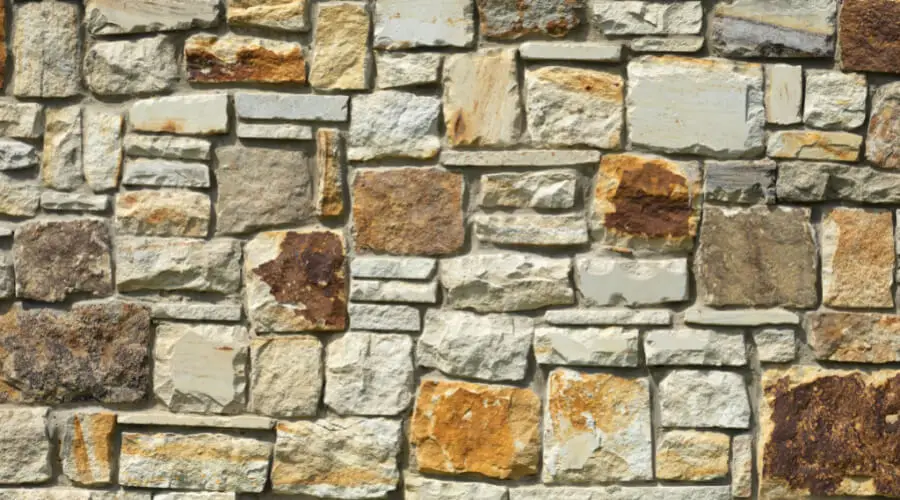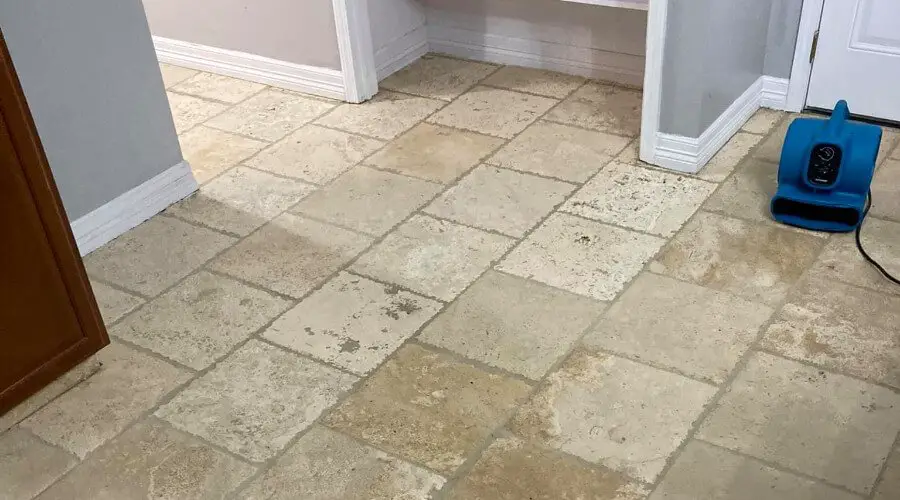Last Updated on July 31, 2023 By Emma W. Thomas
To polish travertine floors, follow these steps:
- Clean the floor thoroughly to remove dirt and debris.
- Use a polishing compound designed for travertine.
- Apply the compound with a buffing machine or hand buffer.
- Work in small sections for even results.
- Wipe off any residue and enjoy the polished shine.
What’s Travertine?

Like granite and marble, travertine is a natural stone that doesn’t have much in common with many other stones. It is typically formed when calcium carbonates condense in hot springs. The stone is hardened by high temperatures, making it durable. They are porous due to carbon bubbles.
Travertine tile is a trendy choice for both outdoor and indoor flooring due to its multiple color options. Also, the variation one can achieve with this durable material. But, this strong flooring may look dull over time. Therefore, the need to polish and restore your worn-out travertine floors to look new again. Call a professional to do the work or DIY and save an extra coin.
Read on to learn how to polish your travertine floors in simple steps;
How To Polish Travertine Floors In Simple Steps?

The finish on your travertine tiles becomes worn out and scratched from chairs, shoes, and pets over time. This leaves your tiles looking unsightly and dull. Polishing removes the scratches, and stains, plus others, and makes it shiny. The cleaning and polishing of the travertine floor are very simple, as discussed below in six steps. Fortunately, you can do it by yourself, but first, you need;
Materials Needed
- Weighted Buffing Machine
- Buffing pads
- Floor stripper
- Shop vacuum
- waterproof tape
- Travertine filler compound
- Steam cleaner
- Polishing powder
- Mop and Bucket
- Protective plastic sheeting
- Sealers
- Water
Step 1: Strip Any Excessive Material
Before polishing your travertine floor, you’ve to start by cleaning the built-up wax and dirt thoroughly for better results. To remove a waxy build-up from your travertine floor, buy a stripper specifically meant for travertine tiles. Apply the stripper to your floor using a fresh mop to spread it. After covering your floor with an even coating of the stripper, wipe your floor repeatedly with clean water until all the dirt and wax are removed.
Step 2: Steam Clean Your Travertine Floor
To achieve a deep clean, use a steam cleaner with hard floor attachments to help remove any remaining grime and dirt. Also, it helps remove some light scratches plus stains from your surface. Steam cleaning will help clean the grout between the tiles. Achieving a high polish is possible only if you start with a nice and clean floor. Steam cleaning is very important while polishing travertine floors.
Step 3: Fill In Any Cracks, Chips, Or Holes.
The next step is to make any repairs required to restore the travertine floor to look new. Filler compounds preferred for travertine like epoxy make it patch chips, cracks, and any glaring imperfections in your tiles. If epoxy isn’t available, use grout of the same color as the travertine because it’s a suitable substitute.
Whichever material you choose to use, follow the manufacturer’s directions on how you will need to mix it. Allow this compound time to cure before moving to the next step.
Step 4: Tape Plastic Sheeting Along The Edges
Protect all your furniture, cabinets, baseboards, and other surfaces around the floor during the polishing process by tapping them off and using plastic sheeting to protect them. Use waterproof tape along the floor’s perimeter, plus plastic sheets to prepare the surfaces for the polishing step. You can move furniture if possible, to get it out of the way. This prevents damage from your buffing machines or the polishing solutions.
Step 5: Polishing Your Travertine Floor
There’re two methods used to achieve glossy polish on the travertine floor, and you need a weighted buffing machine; first, by using different grit pads and attaching them to the bottom of your buffing machine. It will bring your travertine surface to a shine gradually. The pads help remove scratches, remaining stains, and other surface imperfections from the top layer of your travertine tiles.
Polishing also makes the compounds used to fill cracks and holes level and consistent with the rest of the flooring. After completing the first run, continue with the same, using a higher-grit pad with a polishing range from 800-8500. Stop after getting a smooth finish with the right amount of shine you like.
The second method is using polishing powder; its instruction indicates the pad you need for your machine. Sprinkle your powder on the floor and work it on the tile using a buffer machine. Repeat the steps for additional polishing if necessary.
Remember, you’ve to decide how much shine you would like for your floor to have. The higher the number of times you use the polishing powder or the higher the grit, the more gloss you’ll achieve with your floors.
Step 6: Clean Up And Seal
The results after polishing are amazing, although the process might be messy, hence the need for proper clean-up afterward. The clean-up process starts after you’ve restored the travertine floors to their original look. Eliminate any dust that’s sprinkling your floor after the buffing process by mopping it fully with clean water.
To keep the floor looking polished and protected for a longer period apply sealers. Follow the manufacturer’s instructions while applying sealers and allow them to dry fully.
After completing your polishing project, remove all the protective plastic and tape from the baseboards and cabinets. Arrange all your things in place and enjoy the stunning look of your floors all over again.
Tools You Need for Polishing Travertine Floors
Polishing travertine floors is a task that requires specific tools to ensure an impeccable and professional finish. Whether you are a do-it-yourself enthusiast or a professional contractor, understanding the necessary tools for this job can make all the difference. Below is the comprehensive list of essential tools you need for polishing travertine floors.
- Travertine Polishing Powder
- A high-quality polishing powder is essential because it can restore the floor’s shine and smoothness without damaging the travertine stone.
- Stone Sealant
- Once the polishing process is complete, you will need a stone sealant. This product helps protect the polished floor from stains and damages, preserving its glossy look for longer.
- Wet Stone Polisher
- An electric wet stone polisher is a must-have tool. It’s ideal for polishing and finishing the travertine floor to attain the desired shine and smoothness.
- Diamond Polishing Pads
- Diamond polishing pads are perfect for smoothing the surface of the floor, removing scratches, and giving the stone a polished finish.
- Sponges or Rags
- Used for wiping and cleaning the floor during the polishing process. Ensures that no dust or residue is left on the floor.
- Sanitizer, Neutral Cleaner, or Stone Soap
- Regular cleaning of the travertine floors with a mild soap or a neutral cleaner can help maintain the polished look over time.
- Bucket and Mop
- These tools are necessary for keeping the surface clean before and after the polishing process.
- Vacuum Cleaner
- To eliminate all the dust and dirt from the surface and the crevices of the stone floor before the polishing process begins.
| Essential Tools | Description |
|---|---|
| Travertine Polishing Powder | Restores the shine and smoothness |
| Stone Sealant | Protects the polished floor from stains |
| Wet Stone Polisher | Offers the desired shine and smoothness |
| Diamond Polishing Pads | Smoothens the surface and removes scratches |
| Sponges or Rags | Wipes and cleans the floor |
| Sanitizer, Neutral Cleaner, or Stone Soap | Maintains the polished look |
| Bucket and Mop | Keeps the surface clean before and after polishing |
| Vacuum Cleaner | Removes dust and dirt before polishing |
Travertine Floors Maintenance Tips

Travertine might be a strong stone; however, it is sensitive due to its microscopic pores. Here are the maintenance tips you should always keep in mind if you want your travertine tiles to look brand new for an extended period.
- Travertine requires consistent care routines to keep it in top condition. So, it would help if you dusted mop your travertine floor regularly in a week to remove any dust and debris—also, wet mop your surfaces at least once per week, especially in high-traffic areas.
- Clean up any spills instantly to prevent any unsightly stains or etch marks.
- It would be best to protect your floor using mats and rugs, do consider getting rubber furniture. On your kitchen surfaces, you can place individual placemats, trays, trivets, and coasters. In bathrooms, use sink trays and cover the shelves with mats.
- Always clean your travertine shower after a single use. Also, keep it ventilated to prevent moisture.
- Deep clean your travertine floors or other surfaces with a steam cleaner or an automatic scrubber at least twice a year.
- Ensure your travertine tiles plus grout are in top condition. You can do so by checking for discolorations, chipping, and cracks after six months. Call professionals or DIY if you find any problems.
- Using a good quality neutral cleaner on any travertine surfaces would be best, i.e., pH-neutral.
- Be sure the detergents you use are safe for natural stones. Don’t use those commercially available cleaning products that have acidic substances that might damage the stones. Please avoid the use of vinegar or citrus since it will dull your surface.
- Mild cleaners, warm water, and a mop or microfiber cloth are enough to maintain your travertine floor.
- Sweep your floor using a soft broom or dry mop when cleaning or vacuum to remove dust and sand.
- Avoid using hard brooms because they can scratch your travertine surface. Don’t use a full-size canister vacuum; rather, use a handheld one.
- While performing your daily maintenance, it can be a good idea to dry scrub your travertine surface.
- If you seal the stones, your travertine walls or floors can hold up longer. Sealing can be done yearly.
- Always taste your solution on a small spot before starting to make sure they are a safe product.
- If you don’t have suitable cleaners at home, use plain water.
- Please don’t use bleach to clean your travertine floors; it will discolor them.
Different Types Of Damages Your Travertine Floor Can Suffer
- Etching– Caused by acidic substances penetrations.
- Staining– Darker marks occur when substances penetrate the stone.
- Scratches- Moving heavy or sharp objects causes it.
- Mold– These fungi occur when you expose travertine to moisture.
- Dirt Accumulation– If maintenance isn’t done properly, the dirt accumulates in small cracks or pits.
- Mineral deposits are very common whereas tap water is hard water, meaning minerals like calcium and magnesium. It forms if soap residue combines with these minerals.
Final Thought
Well-polished travertine floors elevate the look of any room, making it look amazing and decorous. They’re a popular choice for indoors and outdoors applications, especially in well-used spaces like kitchens and bathrooms.
As for labor-intensive, the polishing process of travertine floors is not that difficult. Restore your worn-out-looking floors to their original shine rather than replacing them by following the six steps discussed in this article. Proper maintenance improves the lifespan of travertine floors.
References:
https://www.titansrestore.com/post/how-to-restore-natural-stone-and-polish-travertine-floor-or-marble-floor-the-ultimate-guide
https://www.hunterpavers.com.au/page/polish-travertine?
Emma is a graduate of Domestic Science or Family and Consumer Sciences (Home Economics) from the University of Wisconsin. She has 7 years of experience Working with the strategic section of BestBuy and now writing full-time for Homeeon.
From Managing the Home, Interiors, Cleaning, and Exteriors to Gardening and everything about Making A Home Liveable – is her passion and this Homeeon is the result of this.
Emma loves decorating her home with the best stuff found online. She cares about quality over anything and writes reviews about them here in Homeeon. Get in touch with her over Pinterest.
Keep reading her blogs.

